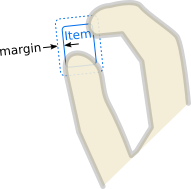PointerHandler QML Type
Abstract handler for pointer events. More...
| Import Statement: | import QtQuick 2.15 |
| Since: | Qt 5.10 |
| Inherited By: |
Properties
- active : bool
- cursorShape : Qt::CursorShape
- dragThreshold : int
- enabled : bool
- grabPermissions : flags
- margin : real
- parent : Item
- target : Item
Signals
- canceled(EventPoint point)
- grabChanged(GrabTransition transition, EventPoint point)
Detailed Description
PointerHandler is the base class Input Handler (not registered as a QML type) for events from any kind of pointing device (touch, mouse or graphics tablet).
Property Documentation
This holds true whenever this Input Handler has taken sole responsibility for handing one or more EventPoints, by successfully taking an exclusive grab of those points. This means that it is keeping its properties up-to-date according to the movements of those Event Points and actively manipulating its target (if any).
This property holds the cursor shape that will appear whenever the mouse is hovering over the parentItem while active is true.
The available cursor shapes are:
- Qt.ArrowCursor
- Qt.UpArrowCursor
- Qt.CrossCursor
- Qt.WaitCursor
- Qt.IBeamCursor
- Qt.SizeVerCursor
- Qt.SizeHorCursor
- Qt.SizeBDiagCursor
- Qt.SizeFDiagCursor
- Qt.SizeAllCursor
- Qt.BlankCursor
- Qt.SplitVCursor
- Qt.SplitHCursor
- Qt.PointingHandCursor
- Qt.ForbiddenCursor
- Qt.WhatsThisCursor
- Qt.BusyCursor
- Qt.OpenHandCursor
- Qt.ClosedHandCursor
- Qt.DragCopyCursor
- Qt.DragMoveCursor
- Qt.DragLinkCursor
The default value is not set, which allows the cursor of parentItem to appear. This property can be reset to the same initial condition by setting it to undefined.
Note: When this property has not been set, or has been set to undefined, if you read the value it will return Qt.ArrowCursor.
This property was introduced in Qt 5.15.
See also Qt::CursorShape, QQuickItem::cursor(), and HoverHandler::cursorShape.
The distance in pixels that the user must drag an event point in order to have it treated as a drag gesture.
The default value depends on the platform and screen resolution. It can be reset back to the default value by setting it to undefined. The behavior when a drag gesture begins varies in different handlers.
This property was introduced in Qt 5.15.
If a PointerHandler is disabled, it will reject all events and no signals will be emitted.
This property specifies the permissions when this handler's logic decides to take over the exclusive grab, or when it is asked to approve grab takeover or cancellation by another handler.
| Constant | Description |
|---|---|
PointerHandler.TakeOverForbidden | This handler neither takes from nor gives grab permission to any type of Item or Handler. |
PointerHandler.CanTakeOverFromHandlersOfSameType | This handler can take the exclusive grab from another handler of the same class. |
PointerHandler.CanTakeOverFromHandlersOfDifferentType | This handler can take the exclusive grab from any kind of handler. |
PointerHandler.CanTakeOverFromItems | This handler can take the exclusive grab from any type of Item. |
PointerHandler.CanTakeOverFromAnything | This handler can take the exclusive grab from any type of Item or Handler. |
PointerHandler.ApprovesTakeOverByHandlersOfSameType | This handler gives permission for another handler of the same class to take the grab. |
PointerHandler.ApprovesTakeOverByHandlersOfDifferentType | This handler gives permission for any kind of handler to take the grab. |
PointerHandler.ApprovesTakeOverByItems | This handler gives permission for any kind of Item to take the grab. |
PointerHandler.ApprovesCancellation | This handler will allow its grab to be set to null. |
PointerHandler.ApprovesTakeOverByAnything | This handler gives permission for any any type of Item or Handler to take the grab. |
The default is PointerHandler.CanTakeOverFromItems | PointerHandler.CanTakeOverFromHandlersOfDifferentType | PointerHandler.ApprovesTakeOverByAnything which allows most takeover scenarios but avoids e.g. two PinchHandlers fighting over the same touchpoints.
The margin beyond the bounds of the parent item within which an event point can activate this handler. For example, on a PinchHandler where the target is also the parent, it's useful to set this to a distance at least half the width of a typical user's finger, so that if the parent has been scaled down to a very small size, the pinch gesture is still possible. Or, if a TapHandler-based button is placed near the screen edge, it can be used to comply with Fitts's Law: react to mouse clicks at the screen edge even though the button is visually spaced away from the edge by a few pixels.
The default value is 0.

[read-only] parent : Item |
The Item which is the scope of the handler; the Item in which it was declared. The handler will handle events on behalf of this Item, which means a pointer event is relevant if at least one of its event points occurs within the Item's interior. Initially target() is the same, but it can be reassigned.
See also target and QObject::parent().
target : Item |
The Item which this handler will manipulate.
By default, it is the same as the parent, the Item within which the handler is declared. However, it can sometimes be useful to set the target to a different Item, in order to handle events within one item but manipulate another; or to null, to disable the default behavior and do something else instead.
Signal Documentation
canceled(EventPoint point) |
If this handler has already grabbed the given point, this signal is emitted when the grab is stolen by a different Pointer Handler or Item.
Note: The corresponding handler is onCanceled.
grabChanged(GrabTransition transition, EventPoint point) |
This signal is emitted when the grab has changed in some way which is relevant to this handler.
The transition (verb) tells what happened. The point (object) is the point that was grabbed or ungrabbed.
Note: The corresponding handler is onGrabChanged.